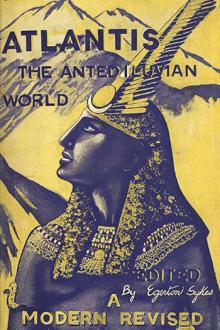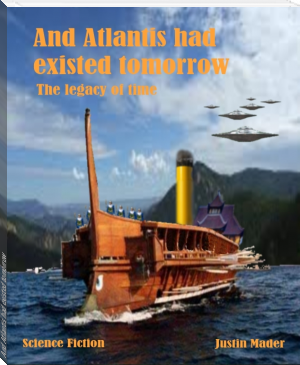Atlantis: The Antedeluvian World by Ignatius Donnelly (thriller novels to read .TXT) 📕

- Author: Ignatius Donnelly
- Performer: -
Book online «Atlantis: The Antedeluvian World by Ignatius Donnelly (thriller novels to read .TXT) 📕». Author Ignatius Donnelly
4. We find in America numerous representations of the elephant. We are forced to one of two conclusions: either the monuments date back to the time of the mammoth in North America, or these people held intercourse at some time in the past with races who possessed the elephant, and from whom they obtained pictures of that singular animal. Plato tells us that the Atlanteans possessed great numbers of elephants.
There are in Wisconsin a number of mounds of earth representing different animals-men, birds, and quadrupeds.
ELEPHANT PIPE, LOISA COUNTY, IOWA.Among the latter is a mound representing an elephant, “so perfect in its proportions, and complete in its representation of an elephant, that its builders must have been well acquainted with all the physical characteristics of the animal which they delineated.” We copy the representation of this mound on page 168.
On a farm in Louisa County, Iowa, a pipe was ploughed up which also represents an elephant. We are indebted to the valuable work of John T.
Short (“The North Americans of Antiquity,” p. 530) for a picture of this singular object. It was found in a section where the ancient mounds were very abundant and rich in relies. The pipe is of sandstone, of the ordinary Mound-Builder’s type, and has every appearance of age and usage. There can be no doubt of its genuineness. The finder had no conception of its archæological value.
In the ruined city of Palenque we find, in one of the palaces, a stucco bass-relief of a priest. His elaborate head-dress or helmet represents very faithfully the bead of an elephant. The cut on page 169 is from a drawing made by Waldeck.
The decoration known as “elephant-trunks” is found in many parts of the ancient ruins of Central America, projecting from above the door-ways of the buildings.
In Tylor’s “Researches into the Early History of Mankind,” p. 313, I find a remarkable representation of an elephant, taken from an ancient Mexican manuscript. It is as follows:
MEXICAN REPRESENTATION OF ELEPHANT.CHAPTER IV.
CORROBORATING CIRCUMSTANCES.
1. Lenormant insists that the human race issued from Ups Merou, and adds that some Greek traditions point to “this locality—particularly the expression me’ropes a?‘nðwpoi, which can only mean ‘the men sprung from Merou.’” (“Manual,” p.21.)
Theopompus tells us that the people who inhabited Atlantis were the Meropes, the people of Merou.
2. Whence comes the word Atlantic? The dictionaries tell us that the ocean is named after the mountains of Atlas; but whence did the Atlas mountains get their name?
“The words Atlas and Atlantic have no satisfactory etymology in any language known to Europe. They are not Greek, and cannot be referred to any known language of the Old World. But in the Nahuatl language we find immediately the radical a, atl, which signifies water, war, and the top of the head. (Molina, “Vocab. en lengua Mexicana y Castellana.”) From this comes a series of words, such as atlan—on the border of or amid the water—from which we ‘have the adjective Atlantic. We have also atlaça, to combat, or be in agony; it means likewise to hurl or dart from the water, and in the preterit makes Atlaz. A city named Atlan existed when the continent was discovered by Columbus, at the entrance of the Gulf of Uraba, in Darien. With a good harbor, it is now reduced to an unimportant pueblo named Acla.” (Baldwin’s “Ancient America,” p.
179.)
Plato tells us that Atlantis and the Atlantic Ocean were named after Atlas, the eldest son of Poseidon, the founder of the kingdom.
3. Upon that part of the African continent nearest to the site of Atlantis we find a chain of mountains, known from the most ancient times as the Atlas Mountains. Whence this name Atlas, if it be not from the name of the great king of Atlantis? And if this be not its origin, how comes it that we find it in the most north-western corner of Africa? And how does it happen that in the time of Herodotus there dwelt near this mountain-chain a people called the Atlantes, probably a remnant of a colony from Solon’s island? How comes it that the people of the Barbary States were known to the Greeks, Romans, and Carthaginians as the “Atlantes,” this name being especially applied to the inhabitants of Fezzan and Bilma? Where did they get the name from? There is no etymology for it east of the Atlantic Ocean. (Lenormants “Anc. Hist. of the East,” p. 253.)
Look at it! An “Atlas” mountain on the shore of Africa; an “Atlan” town on the shore of America; the “Atlantes” living along the north and west coast of Africa; an Aztec people from Aztlan, in Central America; an ocean rolling between the two worlds called the “Atlantic;” a mythological deity called “Atlas” holding the world on his shoulders; and an immemorial tradition of an island of Atlantis. Can all these things be the result of accident?
4. Plato says that there was a “passage west from Atlantis to the rest of the islands, as well as from these islands to the whole opposite continent that surrounds that real sea.” He calls it a real sea, as contradistinguished from the Mediterranean, which, as he says, is not a real sea (or ocean) but a landlocked body of water, like a harbor.
Now, Plato might have created Atlantis out of his imagination; but how could he have invented the islands beyond (the West India Islands), and the whole continent (America) enclosing that real sea? If we look at the map, we see that the continent of America does “surround” the ocean in a great half-circle. Could Plato have guessed all this? If there had been no Atlantis, and no series of voyages from it that revealed the half-circle of the continent from Newfoundland to Cape St. Roche, how could Plato have guessed it? And how could he have known that the Mediterranean was only a harbor compared with the magnitude of the great ocean surrounding Atlantis? Long sea-voyages were necessary to establish that fact, and the Greeks, who kept close to the shores in their short journeys, did not make such voyages.
5. How can we, without Atlantis, explain the presence of the Basques in Europe, who have no lingual affinities with any other race on the continent of Europe, but whose language is similar to the languages of America?
Plato tells us that the dominion of Gadeirus, one of the kings of Atlantis, extended “toward the pillars of Heracles (Hercules) as far as the country which is still called the region of Gades in that part of the world.” Gades is the Cadiz of today, and the dominion of Gadeirus embraced the land of the Iberians or Basques, their chief city taking its name from a king of Atlantis, and they themselves being Atlanteans.
Dr. Farrar, referring to the Basque language, says: “What is certain about it is, that its structure is polysynthetic, like the languages of America. Like them, it forms its compounds by the elimination of certain radicals in the simple words; so that ilhun, the twilight, is contracted from hill, dead, and egun, day; and belhaur, the knee, from belhar, front, and oin, leg. . . . The fact is indisputable, and is eminently noteworthy, that while the affinities of the Basque roots have never been conclusively elucidated, there has never been any doubt that this isolated language, preserving its identity in a western corner of Europe, between two mighty kingdoms, resembles, in its grammatical structure, the aboriginal languages of the vast opposite continent (America), and those alone.” (“Families of Speech,” p. 132.) If there was an Atlantis, forming, with its connecting ridges, a continuous bridge of land from America to Africa, we can understand how the Basques could have passed from one continent to another; but if the wide Atlantic rolled at all times unbroken between the two continents, it is difficult to conceive of such an emigration by an uncivilized people.
6. Without Atlantis, how can we explain the fact that the early Egyptians were depicted by themselves as red men on their own monuments?
And, on the other hand, how can we account for the representations of negroes on the monuments of Central America?
Dêsirè Charnay, now engaged in exploring those monuments, has published in the North American Review for December, 1880, photographs of a number of idols exhumed at San Juan de Teotihuacan, from which I select the following strikingly negroid faces:
NEGRO IDOLS FOUND IN MEXICO.Dr. Le Plongeon says:
“Besides the sculptures of long-bearded men seen by the explorer at Chichen Itza, there were tall figures of people with small heads, thick lips, and curly short hair or wool, regarded as negroes. ‘We always see them as standard or parasol bearers, but never engaged in actual warfare.’” (“Maya Archæology,” p. 62.) The following cut is from the court of the Palace of Palenque, figured by Stephens. The face is strongly Ethiopian.
The figure below represents a gigantic granite head, found near the volcano of Tuxtla, in the Mexican State of Vera Cruz, at Caxapa. The features are unmistakably negroid.
As the negroes have never been a sea-going race, the presence of these faces among the antiquities of Central America proves one of two things, either the existence of a land connection between America and Africa via Atlantis, as revealed by the deep-sea soundings of the Challenger, or commercial relations between America and Africa through the ships of the Atlanteans or some other civilized race, whereby the negroes were brought to America as slaves at a very remote epoch.
And we find some corroboration of the latter theory in that singular book of the Quiches, the “Popol Vuh,” in which, after describing the creation of the first men “in the region of the rising sun” (Bancroft’s “Native Races,” vol. v., p. 548), and enumerating their first generations, we are told, “All seem to have spoken one language, and to have lived in great peace, black men and white together. Here they awaited the rising of the sun, and prayed to the Heart of Heaven.”
(Bancroft’s “Native Races,” p. 547.) How did the red men of Central America know anything about “black men and white men?” The conclusion seems inevitable that these legends of a primitive, peaceful, and happy land, an Aztlan in the East, inhabited by black and white men, to which all the civilized nations of America traced their origin, could only refer to Atlantis—that bridge of land where the white, dark, and red races met. The “Popol Vuh” proceeds to tell how this first home of the race became over-populous, and how the people under Balam-Quitze migrated; how their language became “confounded,” in other words, broken up into dialects, in consequence of separation; and how some of the people “went to the East, and many came hither to Guatemala.” (Ibid., p.
547.)
M. A. de Quatrefages (“Human Species,” p. 200) says, “Black populations have been found in America in very small numbers only, as isolated tribes in the midst of very different populations. Such are the Charruas, of Brazil, the Black Carribees of Saint Vincent, in the Gulf of Mexico; the Jamassi of Florida, and the dark-complexioned Californians. . . . Such, again, is





Comments (0)